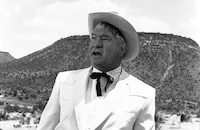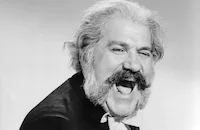First off, producer Joe Pasternak (1901-1991) was no slouch when it came to concocting teenage fare - having made his mark early on at Universal with the Deanna Durbin smash hits Three Smart Girls (1936) and One Hundred Men and a Girl, released the following year.
From Universal and Deanna Durbin, Pasternak moved on to MGM and June Allyson and Jane Powell, where he became a sort of junior Arthur Freed, helming the more modestly-budgeted musicals, which may not have carried the critical weight of a Meet Me in St. Louis (1944) or Ziegfeld Follies (1946), but made up for it with style, gusto and an uncanny ability to zero in on the youth market. Pictures such as Two Girls and a Sailor (1944), A Date With Judy (1948), Nancy Goes to Rio (1950) and Small Town Girl (1953) struck box office gold and MGM showed its gratitude by giving the Hungarian-born dynamo (who began his Hollywood tenure as a waiter in the Paramount commissary) an occasional prestige project like Anchors Aweigh (1945), Summer Stock (1950) and The Great Caruso (1951), all of which he handled with panache.
The unenviable task of scripting Where the Boys Are fell to MGM veteran George Wells whose lighthearted touch graced many successful Metro items in the 1940s and 50s, including Take Me Out to the Ball Game (1949), Three Little Words (1950), and Designing Woman (1957). However, fans of the original Glendon Swarthout novel regretted that his uncompromising satire on American pubescence rites-of-passage reached the screen in a considerably watered-down version. Still, Wells did manage to include a rather graphic interlude of date rape involving one of the major characters, certainly unusual for a sixties teen romance. Perhaps it wasn't so surprising considering Wells' ability to throw that left of center curve in such previous films as the cynical Madison Avenue drama about advertising - The Hucksters (1947) and the black comedy, The Gazebo (1959).
The versatile cast of Where the Boys Are now reads like a 'who's who' of sixties icons. To start with there's male lead George Hamilton who seems to have modeled his off and on-screen personae of the always suntanned millionaire playboy on this movie while his beautiful co-star Dolores Hart can lay claim to starring opposite Elvis Presley in two Paramount back-to-back successes, Loving You (1957) and King Creole (1958). Was that the reason she left acting for the Benedictine order, where she is now known as Mother Dolores?
Then there's Yvette Mimieux, the picture's loose cannon, who comes close to stealing the picture with her disturbing, self-destructive behavior with a group of drunken men. And let's not forget Connie Francis, whose rendition of the theme song stayed on the top ten charts for weeks and remains a standard in her repertoire today.
Unquestionably, the two major finds of the film are the unofficial romantic team of Jim Hutton and Paula Prentiss. Hutton, discovered by director Douglas Sirk while still in the service, made his debut in the director's 1958 war drama, A Time to Love and a Time to Die. A great light comedian, Hutton's height (well over six feet) matched him perfectly with Prentiss, a marvelous underrated comedienne who was also tall and thin and always brought a deft combination of brainy yet kooky sexiness to her many roles. It was her performance in movies like this one which caught director Howard Hawks' eye - and assured her the female lead in his overlooked 1964 gem, Man's Favorite Sport?. Hutton and Prentiss' chemistry worked so well that MGM, in quick succession, cast them in four other comedies, Bachelor in Paradise (1961), The Honeymoon Machine (1961), The Horizontal Lieutenant (1962) and Looking For Love (1964). Other faces to look for: a pre-Riddler Frank Gorshin as a near-sighted jazz musician, Chill Wills as the local sheriff and Sean Flynn, Errol's son, as one of the throngs of swinging collegians.
Premiering at New York's prestigious Radio City Music Hall, Where the Boys Are performed remarkably well - doing even better once it opened wide across the country. Why it endures is probably something that can be debated on both sides of the cultural coin, but perhaps Time Magazine said it best in their review when they pegged it as "...one of those pictures every intelligent moviegoer will loathe himself for liking - a corny, phony, raucous outburst of fraternity humor, sorority sex talk and house-mother homilies that nevertheless warms two hours of winter with a travel-poster panorama of fresh young faces, firm young bodies and good old Florida sunshine..."
Producer: Joe Pasternak
Director: Henry Levin
Screenplay: Glendon Swarthout, George Wells
Art Direction: E. Preston Ames, George W. Davis
Cinematography: Robert J. Bronner
Costume Design: Kitty Mager
Film Editing: Fredric Steinkamp
Original Music: Pete Rugolo, George E. Stoll
Principal Cast: Dolores Hart (Merritt Andrews), George Hamilton (Ryder Smith), Yvette Mimieux (Melanie Coleman), Jim Hutton (TV Thompson), Paula Prentiss (Tuggle Carpenter), Barbara Nichols (Lola), Connie Francis (Angie), Frank Gorshin (Basil), Chill Wills (Police Captain).
C-100m. Letterboxed. Closed captioning. Descriptive Video.
by Mel Neuhaus































